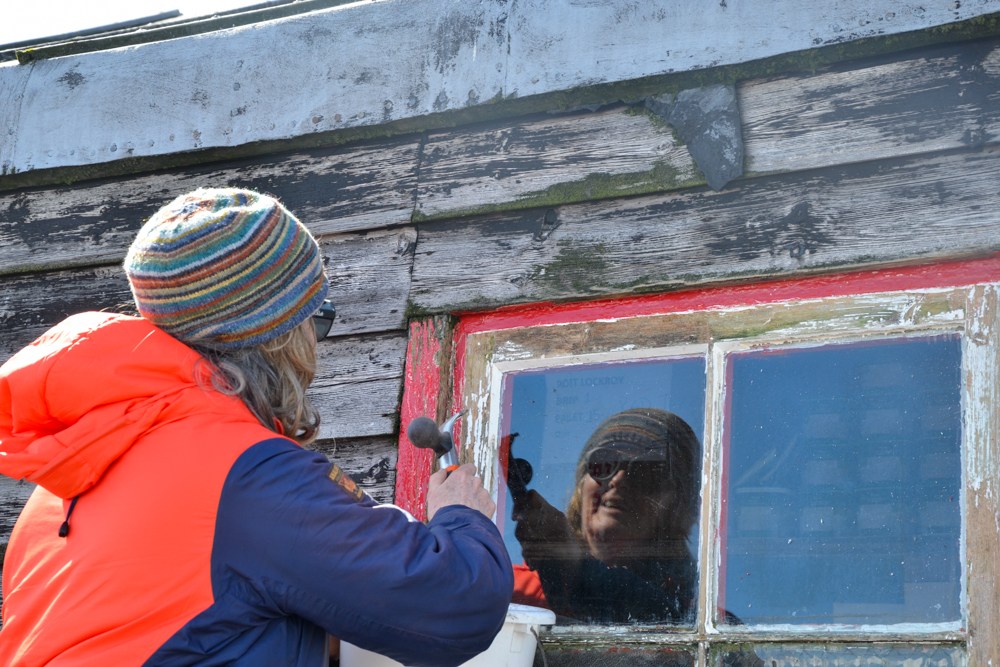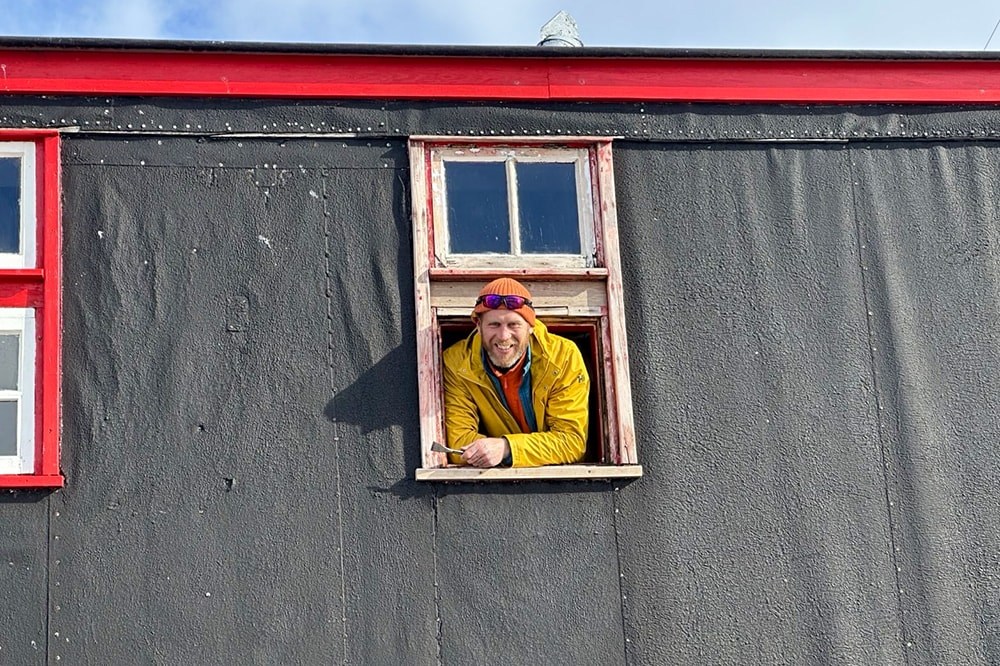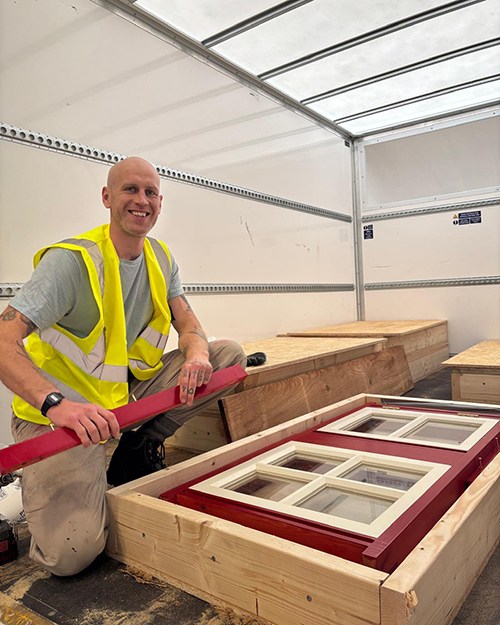Restoring the view: conserving the windows at Port Lockroy
30/10/2025
In the second part of our ongoing conservation series exploring the essential work taking place at Port Lockroy this season, our Head of Buildings and Conservation, Ruth Mullett, talks windows.
A longstanding challenge
For many years, the team at Port Lockroy has faced one of the site’s most persistent challenges: maintaining the historic windows. All the windows at Port Lockroy are made of timber, and they are vulnerable to the increasingly wet conditions now common on the Peninsula.
As Ruth Mullett, UKAHT’s Head of Conservation, explains, the team has been battling moisture and decay for years, and regular maintenance has become ever more difficult. The reasons are multifaceted: the weather detailing on the building does not divert enough water away from the structure, and the operational window for maintenance is very short.

Lisa Ford works on the windows in 2024 (UKAHT/Laura Büllesbach)
Those windows in the new generator shed – now the shop – have proved especially difficult to look after, both because of the limited weather protection on that part of the building and their challenging, hard-to-reach location. As a result, they are now in a very poor state of repair.
Work here is both technically and logistically complex. The building sits on concrete piers above uneven terrain that drops away sharply, making each task slow and challenging. Every step requires careful planning, time, and precision to carry out safely.
Working around penguins and weather
The conditions at Port Lockroy are as unique as its history. The resident gentoo penguins are a defining feature of the site, but their nesting season restricts when conservation work can take place. Teams can only access the new generator shed area once the chicks have fledged – right at the end of the operational season.

Jim working on the windows last season (UKAHT/Dale Ellis)
And even then, the Antarctic weather adds further complexity. There is no point in painting a wet window; the paint would simply flake off within a season, creating both maintenance and environmental issues. To do the job properly, the team needs time and dry conditions – both of which are in short supply.
A radical but necessary approach
Given the extreme challenges of maintaining the new generator shed windows in situ, and their advanced deterioration, the team has made the tough decision to remove the windows and return them to the UK. Once back in the UK, the Trust’s carpenters can fully dry them out and assess them in controlled conditions. In the meantime, bespoke, like-for-like replacements will be fitted at Port Lockroy to preserve the building’s distinctive appearance.

Jim packing the new windows in the UK bound for Port Lockroy (UKAHT/Jim Brearley-Ratcliffe)
These new windows, crafted by conservation carpenter Jim, will replicate every detail of the originals – including historic profiles and joinery – while incorporating subtle improvements such as drip grooves to help water run off more effectively.
“Windows are incredibly significant – they shape a building’s character and tell its story. Our goal is to preserve that heritage, not replace it.” – Ruth Mullett, Head of Buildings and Conservation, UKAHT
Traditional techniques for new challenges
This project also gives the team a chance to test new conservation materials. The replacement windows will be coated with linseed paint – a traditional, breathable finish that lets moisture escape naturally. If it performs well, the results could shape how UKAHT maintains other sites across Antarctica in the future.

A new window (UKAHT/Jim Brearley-Ratcliffe)
It is hoped that the original windows removed from the new generator shed will be able to be repaired and restored. If this is successful, the long-term plan is to establish a rotating window system, with two sets of windows for this vulnerable area. This would make maintenance far more efficient, allowing the team to remove one set for conservation while another remains in place.
Another priority is addressing the root cause of these challenges: too much water sitting against timber windows. This season we’ll also be installing new solutions to help with this, but I’ll talk more about that in my next blog post.
Continuing to welcome visitors
As part of our three-year mission to protect Port Lockroy, the ionospherics room will remain closed for safety for the next two seasons. However, visitors can still explore it virtually through the UKAHT website, and the museum will remain open throughout the season.
“Through careful planning, craftsmanship and patience, we’re preserving not just the windows – but the view into Antarctic history they frame.” – Ruth Mullett, Head of Buildings and Conservation, UKAHT
This period of work also provides a valuable opportunity to study and share the stories connected to the site. As objects are carefully packed and unpacked, the team is learning even more about the history and science of Port Lockroy – knowledge that will be shared through our public engagement programmes.
Ruth Mullett, Head of Buildings and Conservation
If you love a place, protect it
Eighty years in Antarctica have left their mark on this beloved site. Now, Port Lockroy urgently needs restoration to protect its future.
Please donate today.
How your donation will help
We’re seeing more frequent and intense precipitation, both as snow and rain. The historic buildings at Port Lockroy were never designed to withstand this. Meltwater is eroding foundations and damaging walls; the warmer, wetter conditions are causing rot and algae on timber; and internally, this is speeding up the deterioration of artefacts.
In short, the changing climate is not a distant threat; it’s a present-day challenge.
What conservation plans do we have?
- Pack and relocate artefacts to a safe space
- Complete extensive structural works, replacing and strengthening historic floor timbers
- Paint and protect the iconic boatshed
- Replace wooden windows
- Re-felt areas of the historic roof
- Install a climate change mitigation system to prevent water runoff from damaging exterior timbers
What will this work do?
- Secure the immediate safety of Port Lockroy
- Provide long-term protection against climate and environmental damage
- Keep this unique site open as a source of inspiration and connection to Antarctica
Other ways to donate
Please contact our Head of Development, Camilla Johns, via:
Email: camilla.johns@ukaht.org
Post: UK Antarctic Heritage Trust, High Cross, Madingley Road, Cambridge CB3 0ET, UK
Phone: +44 (0)1223 355 049

